Expertly woven jaki-ed (mats) have become a powerful symbol of Marshall Islanders’ resilience in the face of military activity, colonial occupation, and rising sea levels. Historically used as clothing, their production dramatically decreased in the beginning of the 20th century as missionaries, colonial administrations, and merchants introduced cotton cloth that quickly replaced woven textiles made from local materials like pandanus leaves. During World Wars I and II, the islands were successively occupied by German, Japanese, and United States militaries. Supply routes were severely disrupted during World War II, limiting access to trade cloth and providing an opportunity for Marshallese women to begin weaving their customary textiles again.
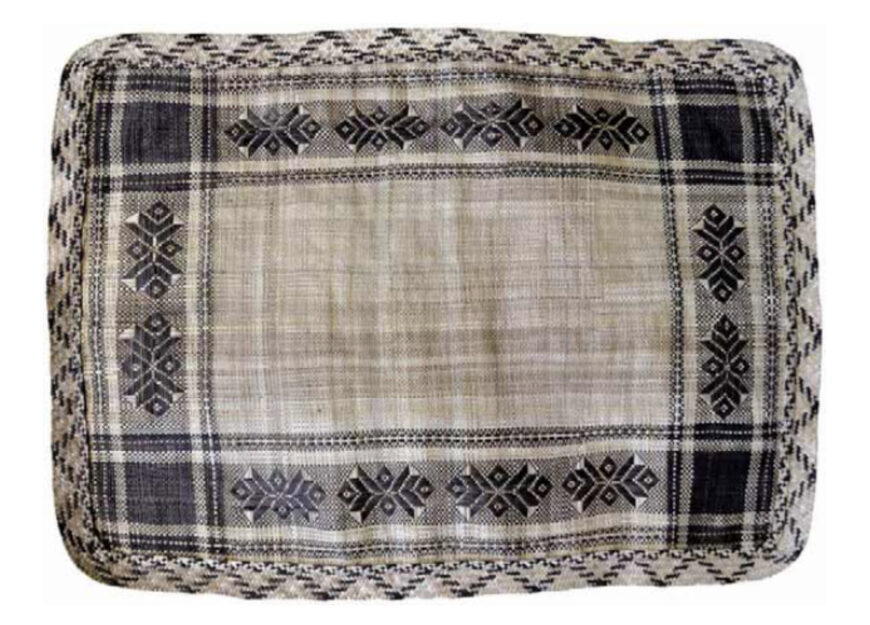
Ashken Binat, Jaki-ed (fine mat), 2010, Wūnmaan̄ (pandanus leaves), dye, string, 18 x 30 inches (photo: T. Greenstone Alefaios) © Ashken Binat
The expert weaver Ashken Binat made this jaki-ed in 2010. It demonstrates the revival of Marshallese weaving since the early 2000s, when a number of workshops and apprenticeship programs helped to recover the intricate knowledge required to produce these fine mats. In Binat’s work, alternating strands of deep black and creamy white form geometric patterns around the edge. Older mats in museum collections, such as the example below from the 19th century, use a wider range of reds and browns to achieve even more complex designs layered in successive bands that surround the undecorated center. Despite the centuries separating these two jaki-ed, both follow a standard form that hints at the continuity and intergenerational connection that woven textiles have enabled over time.
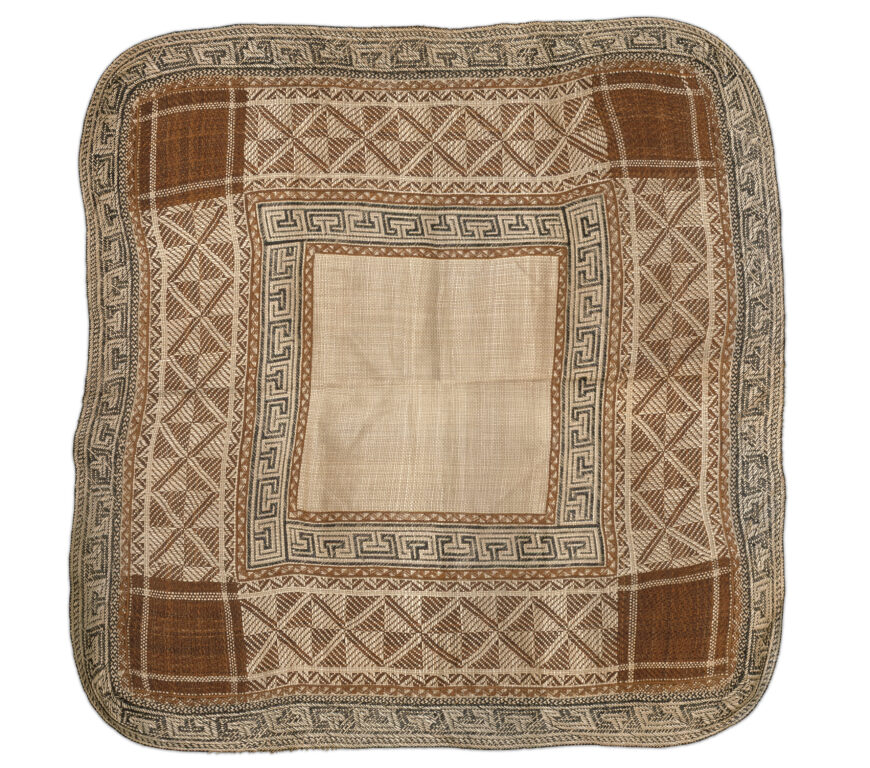
Marshall Islands artist, “Costume mat,” c. 19th century, pandanus, plant fibers, 35 x 35.4 inches (Te Papa Tongarewa Museum of New Zealand, Wellington)
Preparing pandanus
Making a jaki-ed (and other woven works like canoe sails, fans, and baskets) begins with preparing the leaves of the pandanus tree (Pandanus tectorius, called bōb in Marshallese). These leaves, called wūnmaan̄, are large, thick fronds with small spikes that line the edges. To prepare the leaves for weaving, the spikes are first removed with a sharp blade such as a knife or, historically, hard shells. The leaves are then left to dry in the sun, becoming pale in color. The dried fronds are beaten with heavy wooden pounders (dekã in nin) to make them more pliable and then torn into thin strips. Next, the strips are dyed to create darker shades of brown, red, black, and even a deep shade of purple. Customarily, the natural dyes were made of different plant roots, fruit, bark, and soot. Today, these natural dyes are combined with synthetic colors to make even brighter and more elaborate designs.
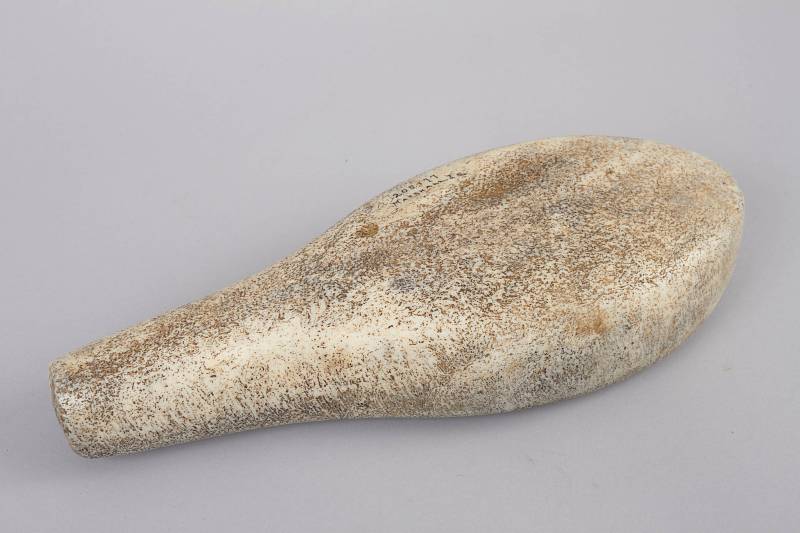
Dekã in nin (pounder) used to beat dried rolls of wūnmaan̄ (pandanus leaves), Marshall Islands (National Museum of Natural History, Smithsonian Institution, Washington, D.C.)
Jaki-ed are woven by women who each create their own mat. And yet, most women do not work in solitude, but rather conduct their weaving in groups where they can share their knowledge, discuss current events, and support one another. Women acquire the knowledge and skills to make woven objects at an early age, learning from their elders and then developing their own aesthetic as they become more experienced. Each jaki-ed is therefore a product of the matrilineal heritage embodied by the artist and her mat.
Symbols of ancestry
The surface of each jaki-ed is made of separate parts: the jouj, or heart, is woven first, and makes up the majority of the mat’s surface. An undecorated square always appears in the center of the jouj and is framed by bands of complex designs called kemejmej. In Ashken Binat’s piece, each corner of the jouj is occupied by a black square flanked by thin, alternating rows of white and black strands, as if the designs are pulsating and radiating outward. Along the length of each side are repeating motifs made up of chevrons and diamonds that appear three-dimensional because of the artist’s expert use of both colors. More thin rows separate these motifs from the central square, which reveals the natural hues of the pandanus leaves as they undulate between different shades of white and beige.

Corners of the jouj and lengthwise chevron and diamond motifs (detail), Ashken Binat, Jaki-ed (fine mat), 2010, Wūnmaan̄ (pandanus leaves), dye, string, 18 x 30 inches (photo: T. Greenstone Alefaios) © Ashken Binat
The mat from the 19th century features even more layers of designs, beginning with the alternating white and reddish-brown squares cut through with star-like Xs, which are separated from the next row of alternating black and white U-shapes by thin, zigzagging lines. The masterful play of positive and negative space within each of these patterns creates a dynamic surface that would have been made even more impressive when wrapped around a person’s body, as it was worn at the time of its manufacture.
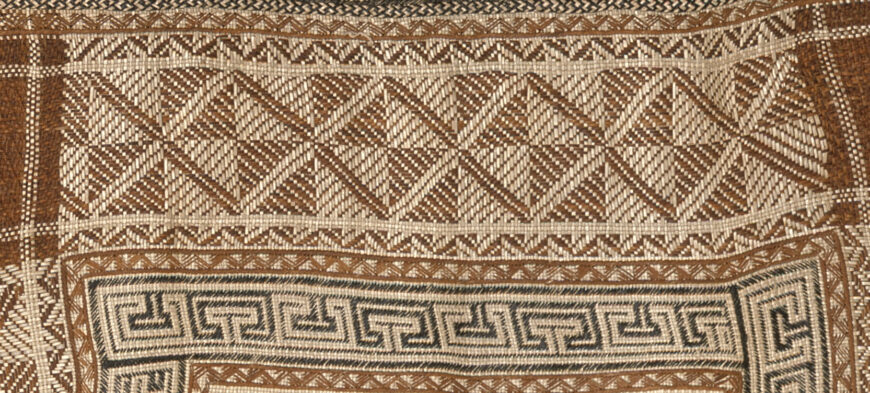
Two patterned rows separated by zigzagging lines (detail), Marshall Islands artist, “Costume mat,” c. 19th century, pandanus, plant fibers, 35 x 35.4 inches (Te Papa Tongarewa Museum of New Zealand, Wellington)
In both examples, the jouj is attached to a decorated border that is woven separately, called the īnīn. This border is often decorated in a similar manner as the jouj, with geometrical patterns and zigzagging lines that echo and reinforce the interior motifs. The īnīn is attached to the jouj with a thick seam called the bo̧kwōj, which is often made of a different, thicker fiber made from tree bark. Attaching the īnīn to the jouj is a critical last step in the production of jaki-ed, for it makes the piece whole, uniting the two parts and, in doing so, making the mat stronger. The bo̧kwōj is often braided and understood to literally weave together the artist’s matrilineal and patrilineal ancestry, creating “a parental embrace safe-guarding the bonds of love, peace, and harmony among members of a jowi (clan).” [1]
Jaki-ed are thus steeped in symbolic meaning, from the motifs to their manufacture. The undecorated core is often associated with purity (perhaps an outcome of the archipelago’s relationship with Christianity resulting from missionary activity beginning in the 19th century), while the motifs around the border indicate the weaver’s ancestry. Some motifs have names passed down as they are taught to younger generations, such as the design on Binat’s mat, which represents the marks that hermit crabs leave in the sand. Other motifs are more abstract in meaning and align the artist with a particular claim to land, status, or title. The repeating designs are often said to represent the children who descend from their ancestors and who will inherit the rights to those lands, while the border designs often refer to the chiefs and clan leaders who protect and embrace the social fabric that keeps Marshallese communities together.
A symbol of vitality & resilience
Jaki-ed continue to be a source of meaning for Marshall Islanders today, especially in the face of external threats to Marshallese culture, bodies, and lands. In the 19th century, customary clothing like nieded—two pieces of jaki-ed wrapped around one’s body—was soon replaced with cotton garments that were obtained through emerging trade networks that brought European and American merchants to the islands. Protestant missionaries also influenced local dress, as conversion was often made visible by wearing dresses, shirts, and trousers that covered the body more fully.
But the most drastic disruptions to Marshallese culture and ways of life occurred in the 20th century, when the islands became a key arena for German, Japanese, and U.S. military activity in the first and second world wars. In the cold-war era following World War II, the United States used the Marshall Islands as a testing site for their nuclear weapons technology, detonating 67 nuclear bombs between 1946 and 1958.
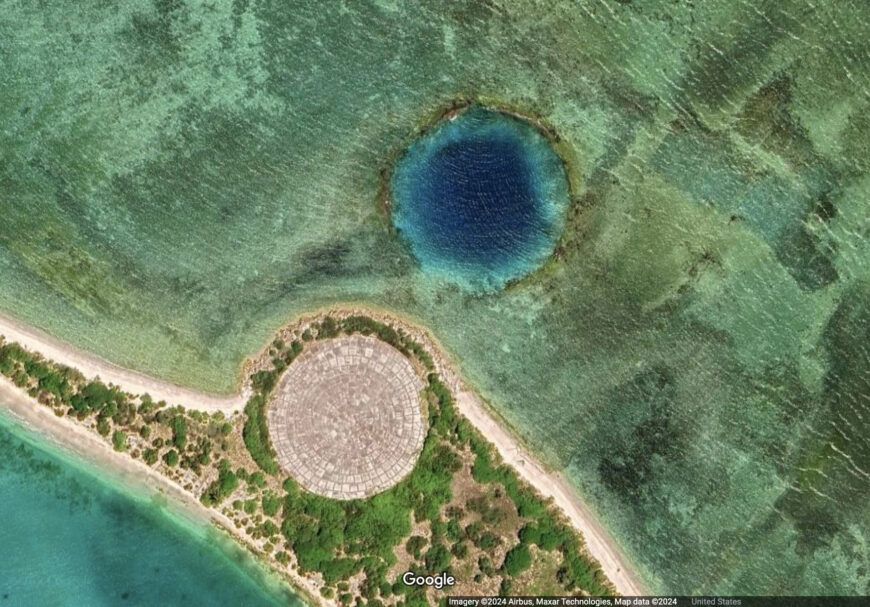
Crater left by a nuclear test on Runit Island, Enewetak Atoll, Republic of the Marshall Islands (photo: © Google Earth)
The devastation of these tests cannot be overstated, as gaping craters replaced the coral atolls that were crucial to the archipelago’s ecological systems, and radioactive waste infiltrated freshwater sources. Marshall Islanders were forcibly relocated by the United States military in advance of the tests, but nevertheless suffered from radiation poisoning and the trauma of being displaced from one’s ancestral home. Today, Marshall Islanders continue to suffer from high rates of cancers related to radiation exposure, and rising sea levels are causing the nuclear waste sites that litter their islands to leak and cause future damage.
In the face of this continuing injustice, Marshall Islanders are using their cultural heritage as a source of recovery and resilience. Jaki-ed mats and the knowledge of pandanus weaving is particularly powerful because of its metaphorical and symbolic meaning attributed to strengthening community ties and maintaining one’s ancestral knowledge in the face of violence and displacement.
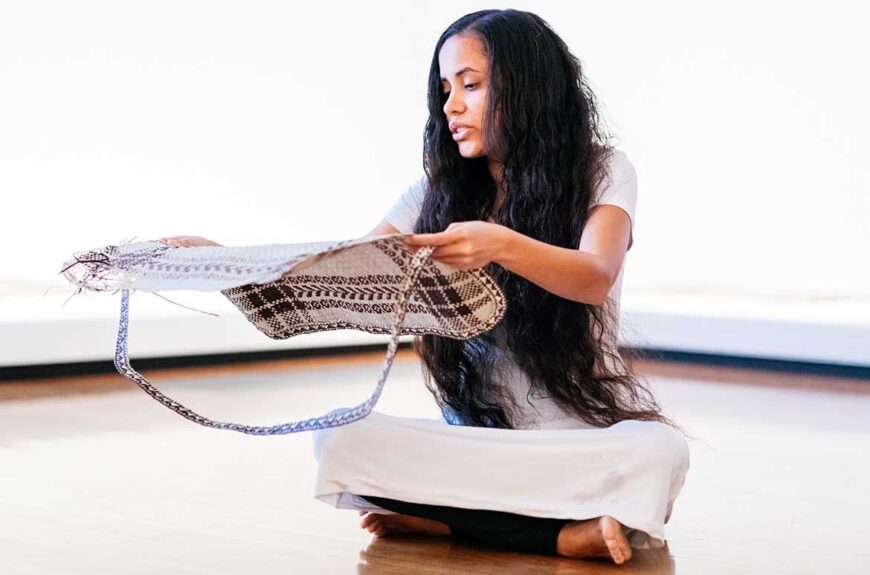
Kathy Jetñil-Kijiner performing Lorro: Of Wings & Seas at the 9th Asia Pacific Triennial, Gallery of Modern Art, Brisbane, Australia, 25 November 2018 (photo: Queensland Art Gallery and Gallery of Modern Art)
In 2017, the Marshallese poet, artist, and climate activist Kathy Jetñil-Kijiner used jaki-ed weaving as a metaphor in her performance Lorro: Of Wings & Seas, in which she recounts learning how to pull together strands, missing a spot, and trying to fill in the gaps that emerge from her own ignorance. In her spoken word performance, that lack of knowledge aptly describes the inability of global powers to adequately address the climate crisis. “I missed a strand,” she says. “I missed a strand and now could we be unravelling?” In this performance, jaki-ed symbolize the strength of ancestors, chiefs, descendants, and clans as well as the global social fabric that is being threatened by climate violence.
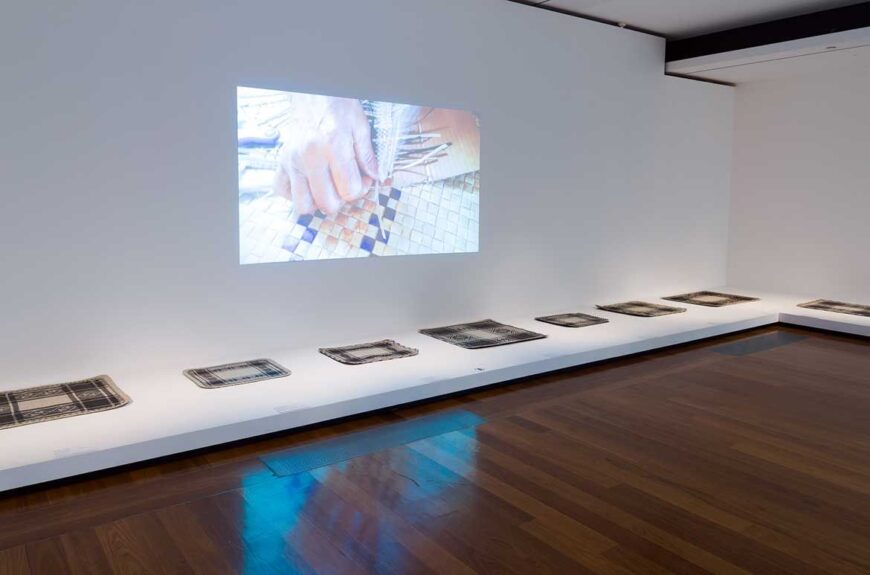
Installation of Jaki-ed mats at the 9th Asia Pacific Triennial, Gallery of Modern Art, Brisbane, Australia, 24 November 2018–28 April 2019 (photo: Queensland Art Gallery and Gallery of Modern Art)
During this performance—which took place at the Gallery of Modern Art in Brisbane, Australia, for the 9th Asia Pacific Triennial of Contemporary Art in 2018–19—Jetñil-Kijiner was surrounded by contemporary jaki-ed that were produced in 2017 during a three-week workshop aimed at revitalizing Marshallese weaving. The weavers span multiple generations, ensuring the knowledge of how to prepare the pandanus and weave specific motifs would continue into the future.
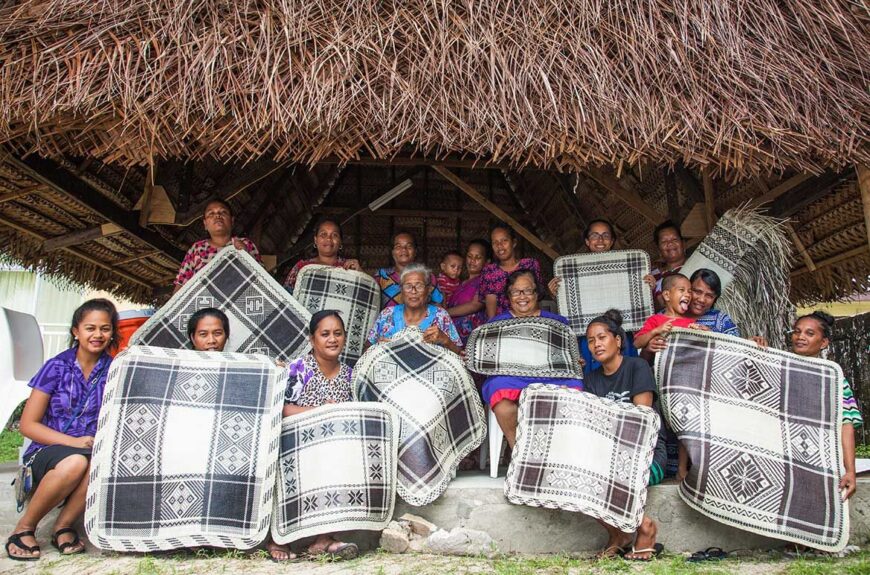
Participants of the Jaki-ed weaving workshop for the the 9th Asia Pacific Triennial at the University of the South Pacific campus in Majuro, Republic of the Marshall Islands, September 2017 (photo: Chewy Lin)
In addition to these workshops and the production of new mats, historical jaki-ed in museum collections are a vital source of knowledge and a symbol of the exceptional artistry and strong culture of ancestors in the past. Many jaki-ed were collected by European and American travelers in the late 19th and early 20th centuries during a time when ethnographic collections were growing in overseas museums. Now, this important record of customary weaving is dispersed across the globe, providing challenges for Marshallese artists to access their heritage. In 2013, the Jaki-ed Program at the University of the South Pacific in Fiji created the Virtual Museum of Marshallese Fine Weaving, a digital tour that allows the global public, no matter where they are, to see the finest jaki-ed in museum collections across the world. Just like Marshall Islanders living in the global diaspora, these historic pieces are crucial means by which people can remain connected to each other, to their heritage, and to emerging generations who will continue to transform and mobilize this knowledge into the future.


